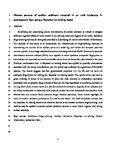Diverse sources of aeolian sediment revealed in an arid landscape in southeastern Iran using a modified Bayesian un-mixing model
| dc.contributor.author | Gholami, H | |
| dc.contributor.author | Dolat Kordestani, M | |
| dc.contributor.author | Li, J | |
| dc.contributor.author | Telfer, Matt | |
| dc.contributor.author | Fathabadi, A | |
| dc.date.accessioned | 2019-11-18T13:00:12Z | |
| dc.date.available | 2019-11-18T13:00:12Z | |
| dc.date.issued | 2019-12 | |
| dc.identifier.issn | 1875-9637 | |
| dc.identifier.issn | 2212-1684 | |
| dc.identifier.other | 100547 | |
| dc.identifier.uri | http://hdl.handle.net/10026.1/15152 | |
| dc.description.abstract |
Identifying and quantifying source contributions of aeolian sediment is critical to mitigate local and regional effects of wind erosion in the arid and semi-arid regions of the world. The purpose of this study is to apply sediment source fingerprinting methods to determine the source contributions of the aeolian sands of a small erg with varied and complex potential sources upwind. A two-stage statistical processes was applied to select optimum composite fingerprints to discriminate the potential sources of the aeolian sands from the Jazmurian plain located in southern Kerman Province, southeastern Iran. A modified Bayesian un-mixing model was applied to quantify uncertainties associated with the source contributions, and the model was evaluated by a mean absolute fit (MAF) method. The results suggest that four geochemical properties (Cr, Co, Ni, and Li) were the optimum fingerprints for solving the modified Bayesian un-mixing model. The results show that there is great diversity in terms of the sources of sand, and that, contrary to expectation, sediments associated with an adjacent large ephemeral lake are the least significant in supplying sediment to the erg. Sand-sheet-derived sands and alluvial sediments dominate the majority of samples, and are likely attributable to relatively short-distance aeolian flux, but substantial contributions from alluvial fans and terraces likely represent longer distance pathways. These results highlight the need to consider sediment provenance on a site-by-site basis. The MAF evaluation showed that the modified Bayesian un-mixing model is an effective method to aid aeolian sediment fingerprinting. This method may be applied to assess aeolian sediment sources in other desert regions with strong aeolian activities. | |
| dc.format.extent | 100547-100547 | |
| dc.language | en | |
| dc.language.iso | en | |
| dc.publisher | Elsevier | |
| dc.subject | Sediment fingerprinting | |
| dc.subject | Aeolian sediment | |
| dc.subject | Modified Bayesian un-mixing model | |
| dc.subject | Uncertainty | |
| dc.subject | Jazmurian plain | |
| dc.subject | Mean absolute fit | |
| dc.title | Diverse sources of aeolian sediment revealed in an arid landscape in southeastern Iran using a modified Bayesian un-mixing model | |
| dc.type | journal-article | |
| dc.type | Journal Article | |
| plymouth.author-url | https://www.webofscience.com/api/gateway?GWVersion=2&SrcApp=PARTNER_APP&SrcAuth=LinksAMR&KeyUT=WOS:000491605300010&DestLinkType=FullRecord&DestApp=ALL_WOS&UsrCustomerID=11bb513d99f797142bcfeffcc58ea008 | |
| plymouth.volume | 41 | |
| plymouth.publication-status | Published | |
| plymouth.journal | Aeolian Research | |
| dc.identifier.doi | 10.1016/j.aeolia.2019.100547 | |
| plymouth.organisational-group | /Plymouth | |
| plymouth.organisational-group | /Plymouth/Faculty of Science and Engineering | |
| plymouth.organisational-group | /Plymouth/Faculty of Science and Engineering/School of Geography, Earth and Environmental Sciences | |
| plymouth.organisational-group | /Plymouth/REF 2021 Researchers by UoA | |
| plymouth.organisational-group | /Plymouth/REF 2021 Researchers by UoA/UoA14 Geography and Environmental Studies | |
| plymouth.organisational-group | /Plymouth/Users by role | |
| plymouth.organisational-group | /Plymouth/Users by role/Academics | |
| dcterms.dateAccepted | 2019-09-19 | |
| dc.rights.embargodate | 2020-9-22 | |
| dc.identifier.eissn | 2212-1684 | |
| dc.rights.embargoperiod | Not known | |
| rioxxterms.versionofrecord | 10.1016/j.aeolia.2019.100547 | |
| rioxxterms.licenseref.uri | http://www.rioxx.net/licenses/all-rights-reserved | |
| rioxxterms.licenseref.startdate | 2019-12 | |
| rioxxterms.type | Journal Article/Review |


